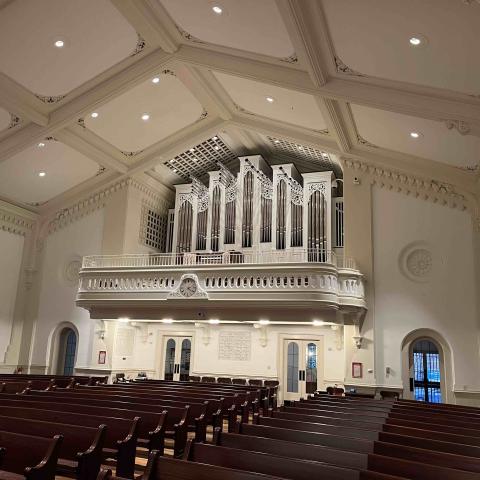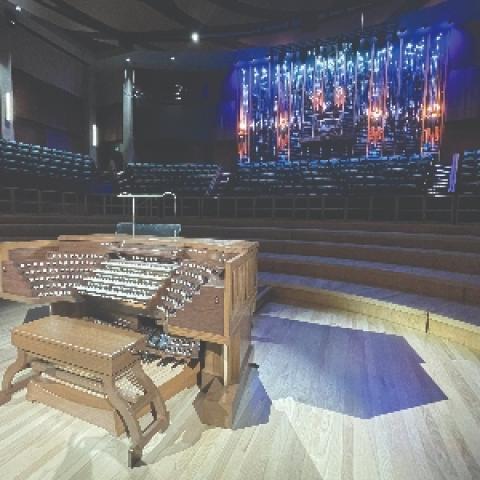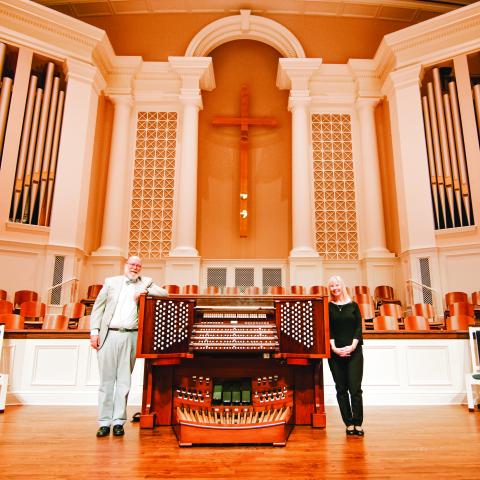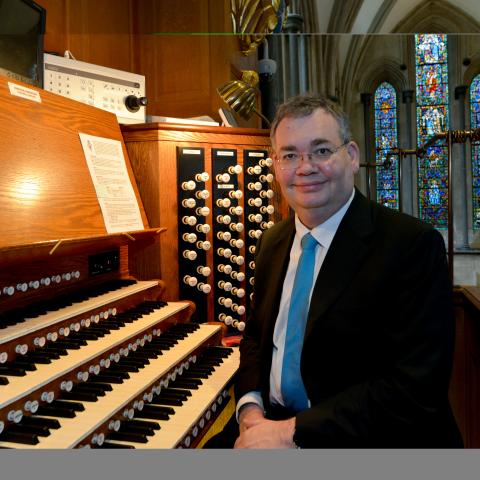Orgues Létourneau, St-Hyacinthe, Québec, Canada; First United Methodist Church, Lubbock, Texas
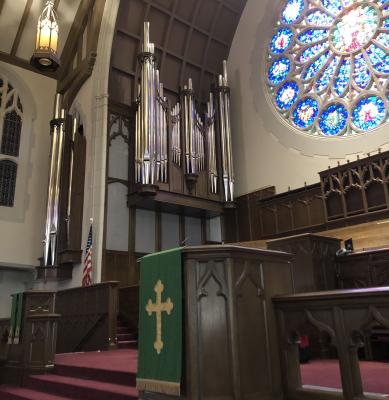
Even when measured by expansive Texan standards, First United Methodist Church in Lubbock is extraordinary in scale. The church’s Gothic bell tower is visible from just about anywhere in downtown Lubbock. The church campus sprawls over two city blocks and includes spacious wings for music, Christian education, youth, and even physical fitness. Completed in 1955, the sanctuary seats over 1,800 people, and its spectacular rose window is reportedly among the eight largest in the world. Confronted with such a voluminous space, organ enthusiasts and builders alike would be forgiven if their thoughts gravitated towards grand schemes. Nonetheless, First Methodist’s sanctuary opened its doors in March of 1955 with M. P. Möller’s Opus 8530, a positively ascetic instrument of 38 ranks spread over seven divisions and located in all four corners of the sanctuary. The organ was played by a three-manual console. Having studied the original pipework and seen the original wind pressure markings as part of this project, the Forrest Memorial Organ was surely understated in its effect.
Möller added a new Great division to the instrument in 1980, introducing visible pipework set on cantilevered chests bracketing the rose window. The original Great was repurposed as a Positiv division, and the other divisions were revised in the fashion of the day, largely replacing foundation tone with new mixtures, cornets, and mutations. Towards the end of the same decade, Möller replaced the 1954 console with a new four-manual console, which allowed the addition of several digital voices by Walker Technical Company.
Möller’s Opus 8530 arrived at its final form a few years later when two new stops built by A. R. Schopp’s & Sons were added to the Swell division, a 4′ Blockflöte and an 8′ Tuba. Now at 54 ranks and supplemented by nearly a dozen digital voices, the instrument could fill the church with sound. The Möller pipework was nonetheless uniformly under-scaled for the space and sounded forced as it was inevitably “pushed” for maximum output. For such a large room, the Pedal division was also curiously limited to two dedicated ranks, a skinny wooden Contrabass and a generous Bourdon.
By the mid 2010s, parts of the instrument were failing. Some of the organ’s larger reed pipes were collapsing, wind reservoirs were audibly leaking, expression mechanisms were unreliable, and the instrument’s electro-pneumatic windchests were ciphering with regularity. The church’s organ committee, ably led by Mr. Danny Johnston, explored options to replace the obsolete Möller mechanisms while retaining as much of the pipework as was practical. The committee travelled to listen to various instruments in Texas, and four companies were invited to submit proposals. Two instruments convinced the committee that Létourneau was the right choice: our Opus 88 at Saint Andrew United Methodist Church in Plano (four manuals, 77 ranks) and our Opus 127 at Saint Mark’s School of Texas in Dallas (three manuals, 61 ranks).
After listening to the church’s aspirations for the project, studying the situation carefully, and surveying the Möller organ’s pipework, we developed a proposal for First United Methodist in several phases that retained nearly thirty ranks from the previous instrument. The project kicked off in the spring of 2019 with the replacement of the Antiphonal Great and Antiphonal Swell organs on either side of the gallery with new Antiphonal and Echo divisions totalling eleven ranks; the voicing was completed later that summer. Independently expressive, these two divisions served as a small but capable instrument for over a year, proving their ability to accompany the church’s adult choir of over seventy voices. With the completion of the chancel organ, these divisions draw sound from the chancel through the long nave, surrounding the congregation with sound without drawing attention to themselves.
As soon as the gallery organ and its two-manual console were ready for service, the dismantling of the chancel organ began. In all parts of the organ, pipes slated for reuse were repaired, cleaned, and in the case of the Möller pipework, liberally rescaled for the new instrument. For example, the scales of the Swell and Antiphonal 8′ Open Diapason stops were enlarged by three and four pipes, respectively. Two of the Möller’s narrow stopped basses were replaced with new wooden pipes for a fuller sound in the 8′ octave. After the addition of seven new pipes at various points in the tenor through soprano octaves, the Möller 8′ Harmonic Flute was completely transformed into the present Antiphonal 4′ Traverse Flute.
The first portion of the chancel organ arrived in Lubbock towards the end of 2019, and a second shipment arrived in early 2020. As the full extent of Covid-19 made itself known, how to continue the organ’s installation became a preoccupation as lockdowns and international travel restrictions sidelined our company’s Québec-based organ builders. After some logistical reshuffling, we engaged a crack team led by Samantha Koch and Daniel Hancock to continue the installation in Lubbock that included the talents of Ryan Boyle, Brian Seever, and Jon Lester. (Daniel and Samantha subsequently joined our team in Québec at the end of 2020.) This last phase of the installation included the Great division and the four 16′ tin façades with their oak casework around the church’s chancel area.
Our Opus 135 is playable from two new consoles. There is a large and traditional four-manual stopknob console in the chancel, and a two-manual console in the gallery with touchscreen controls. The gallery console offers the same stop controls as its larger brother at the other end of the sanctuary, giving organists complete control of the instrument in real time. Both consoles also share the same capture system, allowing the organist to move from one end of the building to the other without concern for registrations. The system boasts 999 levels of memory, as well as an independent sixteen levels of memory for the divisional pistons. Using Solid State Organ System’s powerful MultiSystem II platform, the switching system in all four organ chambers is linked by fiber optic cable for effortlessly rapid communication. Further, the organ has SSOS’s Organist Palette, an iPad interface allowing wireless record-playback throughout the sanctuary, a transposer, and a clock with stopwatch. The Organist Palette offers controls to adjust the General piston sequencer, the various Sostenuto functions, and the point of division for the Pedal Divide feature. Both consoles also use a programmable expression matrix, a concept we borrowed from Richard Houghten, which allows all five of the organ’s expressive divisions to be interchanged between any of the consoles’ three expression pedals.
The new organ’s tonal design took shape in a comfortably English mold, based on a large and noble Great division. Split between the two chancel façades, the Great offers colorful foundation stops, an elegant 16′ principal chorus topped with a six-rank mixture, and large-scale trumpets at 8′ and 4′ pitches. The 16′ Double Diapason is extended to play as the 8′ Open Diapason No. 2; the rank’s slotted pipes are voiced for a harmonically richer timbre to contrast with the larger, more foundational Open Diapason No. 1.
The Swell offers all the dynamic and tonal range one would expect for choral works or organ repertoire. Its specification is disciplined, containing the organ’s secondary principal chorus, a richly colored string and celeste, and a lighthearted chorus of flutes. The Swell foundations smooth the buildup between the Choir and Great divisions but equally reinforce the Great in orchestrally minded registrations. The Swell’s battery of trumpets with English shallots dominates the division without stretching above their station; they enrich the Great ensemble with nuance and color.
The Choir is the tertiary division, with a range of mezzo foundations, from its slotted principals to the open Concert Flute to the delicate Lieblich Gedackt rank. The organ’s softest stops, the Erzähler and Erzähler Celeste, possess more character than a typical Flute Celeste. When used in tandem with the Echo division, the effect is an ethereal shroud over the sanctuary, ideally proportioned to introduce solo colors from the Great, Swell, or Solo. With all the harmonic vibrancy and carrying power of a solo stop, the Choir’s cornet décomposé is still controlled in power such that its mutations can reinforce the principals for smaller contrapuntal works or in alternatim passages with other divisions. Möller’s 8′ English Horn from 1954 was thoroughly revoiced, and its hollow, peaky timbre contrasts beautifully with the Swell’s warm 8′ Oboe. The new Clarinet was fitted with teardrop shallots for a slightly bolder timbre than a prototypical English example without limiting its utility. Both reeds are balanced for use in dialogue with each other against the Swell, but they too can also be strengthened with elements from the cornet.
The Solo division stands out with a strong Doppelflöte and a pair of warm reverse-tapered gambas. The 8′ Tuba pipes by A. R. Schopp’s & Sons merit special mention for their resonators’ enormous scale, as well as their early jump to harmonic length at 4′ C. The Tuba rank was revoiced on nearly seventeen inches pressure with a round, fundamental tone that works beautifully as a solo voice—especially when employed in octaves—but can also buttress the whole ensemble. It will contrast magnificently as the darker foil to the future Trompette en chamade to be installed above the rear gallery. We also added a new 16′ octave to the Tuba using shallots and heavy zinc sheets supplied by Schopp’s for seamless cohesion. Intended to give the pedals the last word in extraordinary circumstances, the 16′ Ophicleide’s effect is especially astonishing from the chancel console!
The organ’s twelve-rank Pedal division features independent metal principals at 16′, 8′, and 4′. A five-rank mixture completes the Pedal chorus, with the mixture incorporating a soft tierce rank for a subtly distinctive timbre. The pedals are reinforced by a large 16′–8′ Open Wood rank and the restored Möller 16′–8′ Subbass, as well as a 16′ Trombone and 8′ Trumpet on nearly six inches pressure. The Pedal is also augmented by four digital 32′ stops provided by Walker, including a penetrating Contra Bass, a subtle Bourdon, a vibrant Contra Trombone, and a milder Contra Fagotto, with this last voice usefully enclosed within the Swell division.
As with any Létourneau instrument, a great deal of reflection went into how Opus 135 could best serve a host of musical needs, whether it is supporting a modern worship service, accompanying a grand choral anthem, or serving as the vehicle to present the organ’s repertoire. We believe the specification bears this out. With 75 ranks and five expressive divisions, there are endless possibilities for creative registration without having to turn the instrument on its head. Each of the main divisions is based on foundations appropriate to the space, with incisive 16′ ranks that enhance their respective choruses without opacity. At the other end of the spectrum, great attention was paid to the role of upperwork with the happy result that the mixtures and higher pitches add presence and texture without overwhelming the balance of the chorus. The overall effect is one of grandeur, cohesion, and warmth.
We have thoroughly enjoyed working with so many fine people at First United Methodist Church during the course of this thrilling project, despite some unexpected twists and turns. Our work has been greatly helped at various points along the way by Danny Johnston, Dr. Seung-Won Cho, David Warren, Keith Bell, and the Reverend Todd Salzwedel. We are also grateful to Mrs. Mary Frances Baucum and the church’s Board of Trustees who were so supportive of the organ committee’s work and recommendations.
In the broader context of the Létourneau company, our Opus 135 for First United Methodist Church is the first instrument completed under the proprietorship of Dudley Oakes (Read about this here). This pipe organ is simultaneously the logical continuation of the artistic evolution that the company was already on and a first expression of our renewed pursuit of tonal excellence. Within the company, there is a growing sense of being in a strong position. The second generation of leadership has many lessons from the past to guide us into the future while still having the freedom to advance in new and exciting directions. With several exciting projects in the years ahead, we invite you to watch this space!
—Orgues Létourneau
GREAT – Manual II – 95mm pressure
16′ Double Diapason, 12 pipes new, extension of Open Diapason No. 2
16′ Lieblich Gedackt — from Choir
8′ Open Diapason No. 1, 61 pipes new, 70% tin
8′ Open Diapason No. 2, 61 pipes new, 70% tin
8′ Harmonic Flute, 61 pipes new, 56% tin
8′ Salicional, 61 pipes new, zinc and 56% tin
8′ Chimney Flute, 61 pipes new, wood and 40% tin
4′ Principal, 61 pipes rescaled Möller pipes
4′ Open Flute, 61 pipes Schopp’s pipes
2-2⁄3′ Twelfth, 61 pipes new, 56% tin
2′ Fifteenth, 61 pipes new, 56% tin
1-1⁄3′ Mixture IV–VI, 306 pipes new, 56% tin
16′ Double Trumpet — from Swell
8′ Trompette, 66 pipes, new, 56% tin
4′ Clairon, 78 pipes, new, 56% tin
8′ Tuba — from Solo
Great Sub Octave
Great Unison Off
Great Octave
Chimes (from Solo)
Zimbelstern
ANTIPHONAL (enclosed) – Manual II – 115mm pressure
16′ Contra Geigen, 12 pipes new, extension of 8′ Geigen
8′ Open Diapason, 61 pipes rescaled Möller pipes
8′ Chimney Flute, 61 pipes Möller pipes with new wood bass
8′ Geigen, 61 pipes new, zinc and 56% tin
4′ Principal, 61 pipes rescaled Möller pipes
4′ Traverse Flute, 61 pipes rescaled Möller pipes
2′ Fifteenth, 61 pipes Möller pipes
Tremulant
Antiphonal Sub Octave
Antiphonal Unison Off
Antiphonal Octave
8′ Trompette en chamade — prepared for future addition
SWELL (enclosed) – Manual III –– 115mm pressure
16′ Contra Gamba, 12 pipes new, extension of 8′ Gamba
8′ Open Diapason, 61 pipes rescaled Möller pipes
8′ Gamba, 61 pipes Möller pipes
8′ Voix Celeste, 54 pipes from g8, Möller pipes with new zinc bass
8′ Bourdon, 61 pipes Möller pipes
4′ Principal, 61 pipes Möller pipes
4′ Harmonic Flute, 61 pipes new, 40% tin
2′ Piccolo, 61 pipes new, 40% tin
2′ Mixture III–V, 247 pipes new, 56% tin
16′ Double Trumpet, 61 pipes new, 56% tin, harmonic at c49
8′ Trumpet, 66 pipes new, 56% tin, harmonic at c37
8′ Oboe, 61 pipes new, 56% tin, capped resonators
8′ Vox Humana, 61 pipes new, 56% tin
4′ Clarion, 78 pipes new, 56% tin, harmonic at c25
Tremulant
Swell Sub Octave
Swell Unison Off
Swell Octave
ECHO (enclosed) – Manual III – 115mm pressure
16′ Bourdon, 12 pipes Möller pipes, extension of 8′ Bourdon
8′ Viole de gambe, 61 pipes Möller pipes
8′ Voix Celeste, 54 pipes from g8, Möller pipes with new zinc bass
8′ Bourdon, 61 pipes Möller pipes
4′ Violon, 61 pipes new, 56% tin
8′ Cor d’amour, 61 pipes Möller pipes, capped resonators
Tremulant
Echo Sub Octave
Echo Unison Off
Echo Octave
CHOIR (enclosed) – Manual I – 110mm pressure
16′ Lieblich Gedackt, 12 pipes new, extension of 8′ Lieblich Gedackt
8′ Geigen Diapason, 61 pipes Möller pipes
8′ Concert Flute, 61 pipes Casavant pipes with new treble
8′ Erzähler, 61 pipes Möller pipes
8′ Erzähler Celeste, 54 pipes from g8, new, zinc and 56% tin
8′ Lieblich Gedackt, 61 pipes Möller pipes with new wood bass
4′ Geigen Principal, 61 pipes new, 56% tin
4′ Koppelflöte, 61 pipes Möller pipes
2-2⁄3′ Nazard, 61 pipes rescaled Möller pipes
2′ Flageolet, 61 pipes rescaled Möller pipes
1-3⁄5′ Tierce, 61 pipes rescaled Möller pipes
1′ Fife, 61 pipes rescaled Möller pipes
8′ English Horn, 61 pipes Möller pipes
8′ Clarinet, 61 pipes new, 56% tin
Tremulant
Choir Sub Octave
Choir Unison Off
Choir Octave
8′ French Horn — from Solo
16′ Ophicleide — from Solo and Pedal
8′ Tuba — from Solo
4′ Tuba — from Solo
8′ Trompette en chamade — from Antiphonal
Harp — from Solo
SOLO (enclosed) – Manual IV – 255mm pressure
8′ Doppelflöte, 61 pipes new, wood and 40% tin
8′ Viola, 61 pipes new, zinc and 56% tin
8′ Viola Celeste, 54 pipes from g8, new, zinc and 56% tin
Tremulant
8′ French Horn, 49 pipes from c13, new, 56% tin, 425mm pressure
8′ Tuba, 85 pipes Schopp’s pipes, 425mm pressure
Solo Sub Octave
Solo Unison Off
Solo Octave
8′ Trompette en chamade — from Antiphonal
Chimes digital Walker Technical Co.
Harp digital Walker Technical Co.
Glockenspiel digital Walker Technical Co.
PEDAL – 105mm pressure
32′ Contra Bass, digital Walker Technical Co.
32′ Contra Bourdon, digital Walker Technical Co.
16′ Open Wood, 32 pipes new, wood
16′ Open Diapason No. 1, 32 pipes new, 70% tin
16′ Open Diapason No. 2 — from Great
16′ Subbass, 32 pipes Möller pipes
16′ Gamba — from Swell
16′ Lieblich Gedackt — from Choir
8′ Open Wood, 12 pipes new, extension of 16′ Open Wood
8′ Principal, 32 pipes new, 56% tin
8′ Subbass, 12 pipes Möller pipes, extension of 16′ Subbass
8′ Gamba — from Swell
8′ Lieblich Gedackt — from Choir
4′ Choral Bass, 32 pipes new, 56% tin
3-1⁄5′ Mixture V, 160 pipes new, 56% tin
32′ Contra Bombarde digital Walker Technical Co.
32′ Contra Fagotto digital enclosed with Swell, Walker Technical Co.
16′ Ophicleide 12 pipes new, zinc and 56% tin, ext. of Solo 8′ Tuba
16′ Trombone 32 pipes new, 145mm pressure
16′ Trumpet — from Swell
8′ Tuba — from Solo
8′ Trumpet 32 pipes new, 145mm pressure
4′ Tuba — from Solo
8′ Trompette en chamade — from Antiphonal
Chimes (from Solo)
ANTIPHONAL PEDAL
16′ Geigen — from Antiphonal
16′ Bourdon — from Echo
8′ Geigen — from Antiphonal
8′ Bourdon — from Echo
97 total stops; 75 ranks; 4,233 pipes
Great Mixture IV–VI
c1 to b12 19 22 26 29
c13 to b24 15 19 22 26
c25 to f#31 12 15 19 22 26
g32 to b36 8 12 15 19 22
c37 to f#43 1 8 12 15 19 22
g44 to e53 1 5 8 12 15 19
f54 to c61 1 5 8 8 12 15
Swell Mixture III–V
c1 to e17 15 19 22
f18 to b36 12 15 19 22
c37 to e41 8 12 15 19
f42 to b48 1 8 12 15 19
c49 to c61 1 8 8 12 15
Pedal Mixture V
c1 to g32 17 19 22 26 29

